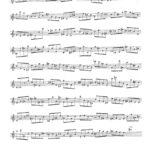| Programme notes: | 60 Studies for Saxophone
Volume One
I hope volume one (31 studies for saxophone) will give saxophonists a chance to develop a fresh approach to playing, whilst improving embouchure and technique. A form of musical weightlifting, these studies will improve the player?s tone and develop stamina.
There are some large intervals that can be pretty tough and some high harmonics which could be tricky, so play them down an octave if necessary. There are no time signatures or key signatures and no naturals, so each note is played as written with a sharp or a flat affecting only the note that it is assigned to.
Most of the studies are written in 8th notes but they don?t have to be played evenly. I would encourage the player to experiment with different rhythmic patterns and indeed different articulations and phrase groupings.
Volume Two
Volume two is basically continuing in the same vein as volume one. Occasionally in the beginning there are some more traditional based patterns. This may help to concentrate anew if playing directly from volume one. The last four studies give a choice of notes to play so you can play the study differently every time. Also they could be played as duets.
The last part of volume two is the Big Key. This is just a personal view of how I see and play music when I?m improvising, expertly written out by Beni Williams.
I would like to emphasize once more these studies are only loose guidelines, please open them up and play them however you want. My sincerest wish to creative musicians is that this book may help expand your facilities and something new to play.
I would like to thank Brian Irvine (volume one) and Tom Bunting (volume two) for putting onto computer my hand written music. Beni Williams for his Big Key article and for transcribing the Philip Gibbs interview. Special thanks also to Andy Isham.
Paul Dunmall |
 Click image to enlarge
Click image to enlarge